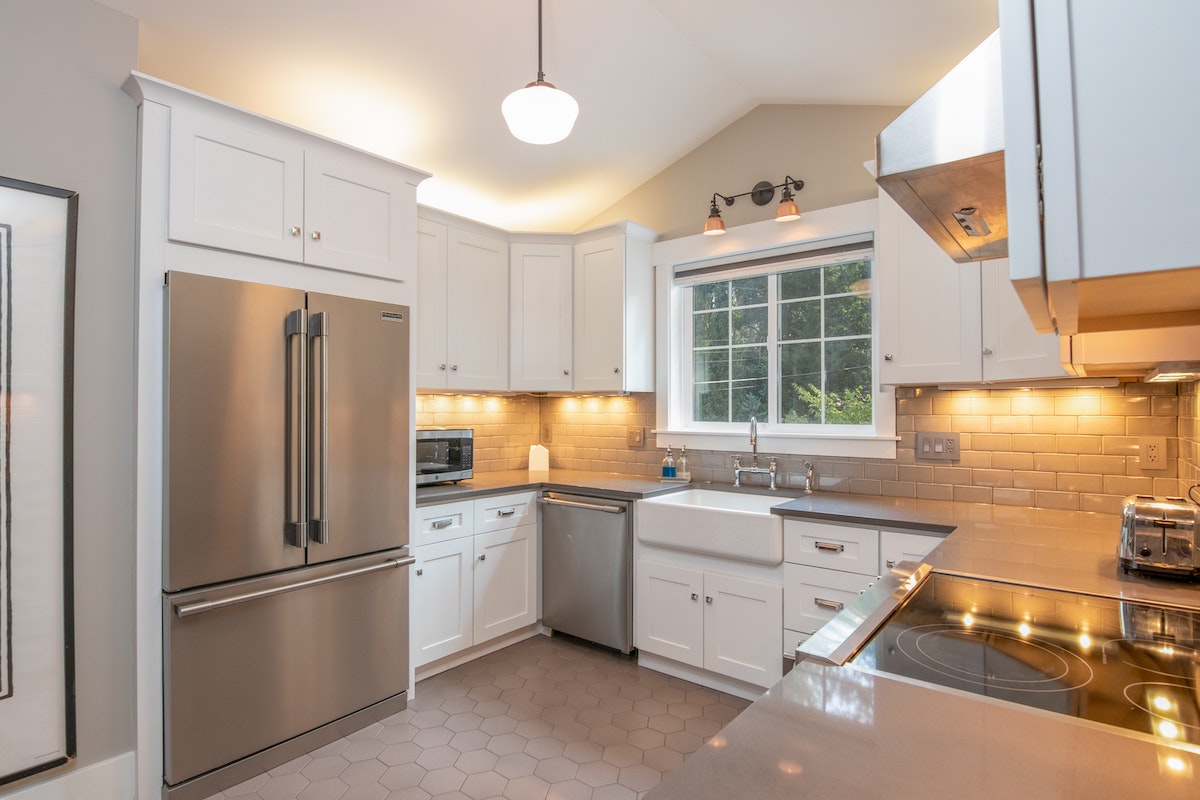By: Frank Engelman | Posted: August 26, 2021 | Updated: March 22, 2023
As part of our “Smart Home Features for Older Adults” series, we are sharing some specific recipes and “kit lists” for individual smart home features — organized on a “room by room” basis. This is about the smart kitchen.
Overview
This article covers several smart kitchen features that author Frank Engelman has found useful for family members or friends — and that focus on “challenges” of particular relevance to people as they age.
Here are the key smart kitchen features Frank has implemented (detailed recipes and “kit lists” included below):
- Automatic, bright, kitchen lighting (including Walk-up under counter lighting with auto-shutoff);
- Fridge Minder (including Verbal alert when a safe temperature limit was exceeded);
- Stove Minder (including Verbal alerts when left on too long; Auto shut-off when left on too long);
- Sink Faucet Minder (including Touchless faucet with Auto shutoff; Leak sensors);
- Trash Minder (including Touchless Trash Can).
Table of Contents
- Videos: See the Smart Kitchen in Action
- The Challenges
- Recipes & Kit Lists
- DIY Tips & Implementation Suggestions
Who Should Read This and Why?
The Smart Home Features for Older Adults series is for anyone who is an older adult, or cares for an older adult, and who likes the idea that some “intelligent home features” might improve quality of life in various ways, and help minimize some of the challenges that come with growing older.
This particular article focuses on the kitchen. For background and the bigger picture, see Smart Home for Seniors: What and Why?.
- To understand some of the “challenges” smart kitchen features can address, read the section on “The Challenges“.
- To see specific detailed recipes (and “kit lists”) for DIY implementations, see “The Recipes & Kit Lists” section.
Things to Note
- Frank likes Alexa (a voice enabled artificial intelligence (AI) made by Amazon), and most of these recipes rely on Alexa as the “brain” that enables the smart solutions to work, and makes a simple voice interface possible.
- Frank’s “recipes” assume a certain amount of DIY capability and tech-savvy-ness on the part of whoever installs these smart kitchen features. However, the recipes assume that the older adult need have no technical capabilities at all.
Disclaimer: This work was not sponsored by Amazon or any other vendor. If you use the outgoing links to vendors in our “kits” and recipes, we may in some cases earn a small commission.
Videos: See the Smart Kitchen in Action
Watch these videos to see some of the smart bathroom features Frank has implemented.
Walk up Touchless Features:
Smart Stove Minder:
The Challenges
Kitchens are especially important for smart home features, because there are some quite major things that can easily go wrong if you are not completely on the ball. For example, the stove being left on — leading to a housefire — is the classic, oft-cited example.
Lighting
Having good bright lighting is very important, because many older adults have less good night vision than when they were younger, and less good balance, and thus are likely to trip, bang into things, or fall if they try and walk around the house in the dark.
So, fumbling for the light switch when you walk up to a kitchen countertop or sink can be a problem. You may even forget to turn off the lights when you leave.
While overhead lighting is great for walking around in the kitchen, good under-cabinet lighting is typically not present in an older home and is costly to retrofit. In addition, the fumbling for the proper light switches can also be an issue and remembering to turn them off can be a hassle.
Luckily, with a simple smart home feature you can enjoy smart lighting!
- See a detailed solution and kit list in the Recipes Section below.
Cognition Issues and Forgetfulness
We think “smart” features can be especially appropriate in situations where an older adult starts to become forgetful, or enters the early stages of cognitive impairment.
The idea that a smart home can help in cases of memory impairment or dementia is not a new one. However recent advances make it much more realistic to incorporate such ideas into an individual’s home.
The key building blocks are:
- The general availability of voice assistants such as Alexa and retrofit devices for switches, lights, and door locks
- The ability of Alexa to serve as a proactive controller and friendly reminder of daily activities.
- “Reminders” when things are left on or open.
- Auto shut-off for devices
This will be a recurring theme as we move from room to room in this Smart Home Features for Older Adults series.
Several of the smart home features in this article are targeted at “forgetfulness”. See them below.
A. Fridge Minder
We worried about a loved one leaving the fridge open, as well as power loss or fridge malfunction.
This can lead to food spoilage as well as some energy wasteage. The big use case for this is when a person has some degree of cognitive impairment, and may not be able to notice if the food is “spoiled”.
- See a detailed solution and kit list in the Recipes Section below.
B. Stove Minder
Oops, I forgot something on the stove… again.
Says Frank:
Based on the personal experiences of my two Aunts and my sister-in-law, I have seen the need for a “stove minder” as discussed by the Longevity Explorers.
See a detailed recipe (with kit lists) for implementing Frank’s solutions to this problem here:
C. Sink Minder
Who left that faucet running? And what about water leaks?
- See a detailed solution and kit list in the Recipes Section below.
Convenience
One of the big benefits of smart home features is “convenience”.
Trash Minder
If you have ever got frustrated about the number of times you need to take action to open the trash can while your hands are dirty or full of something, you will like the “touchless trash can recipe” described below.
- See a detailed solution and kit list in the Recipes Section below.
Recipes and Kit Lists
The following Recipes (& Kit Lists) are authored by Frank Engelman.
1: Automatic Kitchen Lighting
Where is that darn light switch?
The kitchen is one of the most important places to have good lighting for food preparation and general safety.
While overhead lighting is great for walking around in the kitchen, good under-cabinet lighting is typically not present in an older home and is costly to retrofit. In addition, the fumbling for the proper light switches can also be an issue and remembering to turn them off can be a hassle.
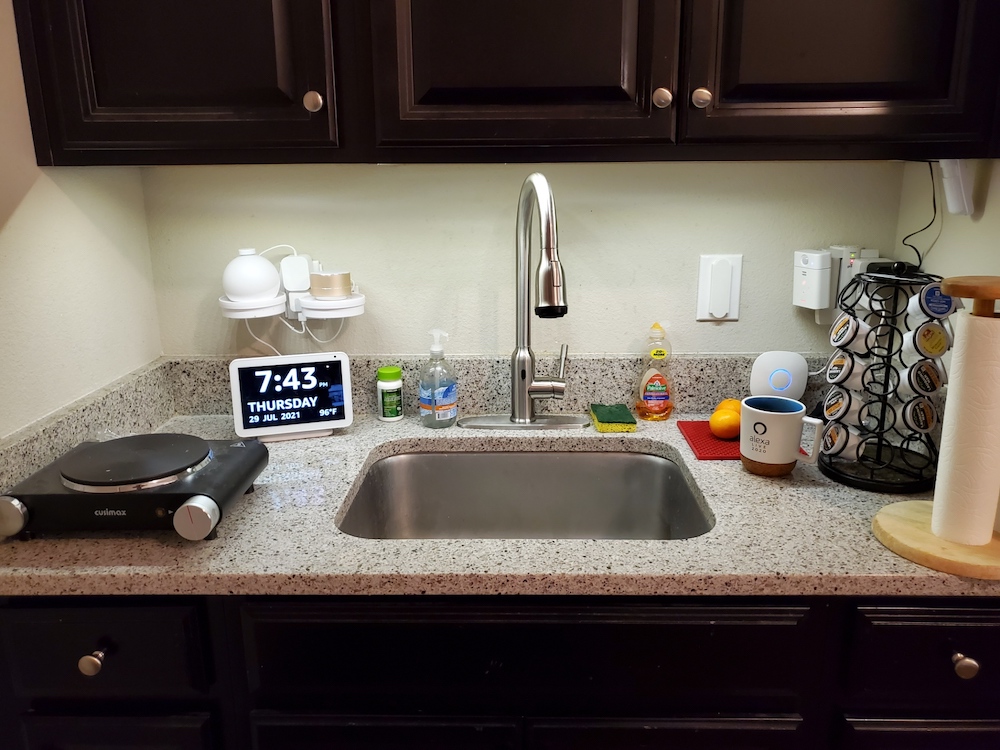
Caption: under-cabinet lighting
Battery-operated Under-counter Lighting
While there are many battery-operated, rechargeable, motion-sensing, LED lights suitable for under-counter lighting, I ran into some testing issues. Some of them were too dim, or the motion sensing required your hands to be right under the sensor for them to turn on the lights.
The rechargeable lights are usually magnetically attached with an adhesive metal strip to the cabinet underside for easy removal for charging. They can be easily charged with your smartphone charger or other USB charger. Since my kitchen is very dark, I found that I needed to remove the lights monthly to recharge them.
- You will find the one I selected in the Smart Kitchen Kit List.
If you hate batteries…
If you are willing to do some installation work and have a power outlet near the cabinets, I’d like to suggest the Alexa controlled solution that I use.
This consists of an Amazon Echo Flex with a motion sensor and a “smart plug” to turn on an AC-powered light strip.
In addition to never having to charge the batteries, it has the advantage of brighter, warmer, lighting and the ability to control how close your loved one needs to be to turn on the lighting as well as how long the lights stay on. You also have the flexibility to automatically turn on the under-counter lighting when the main lighting is switched on providing a more inviting experience.
Of course, this is more complex than the battery-operated solution and doesn’t provide lighting during a power outage.
- If you want to implement automatic kitchen lighting, see the Smart Kitchen Kit List for specific products and Routines to use.
Please refer to our article on “Simple Smart Home Lights” for some ideas on creating Alexa Routines triggered by motion sensors.
2: Fridge Minder
I implemented ways to detect both a door left open, and issues with temperature and malfunction.
Who left the fridge door open?
While we all may keep the fridge door open a while when searching for something to eat, your loved one may also forget to close it. This could result in wasted energy or even undetected food spoilage. You could install door sensors on the fridge and freezer doors to determine if they have been left open too long.
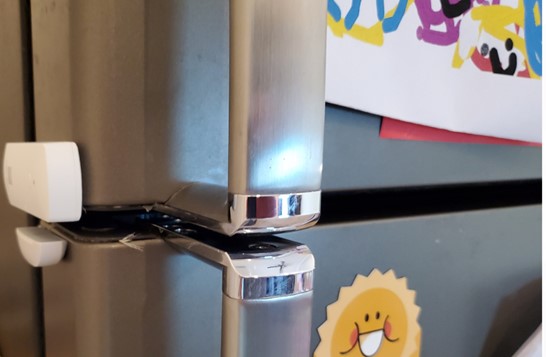
Caption: fridge and freezer door sensor
But, it takes a bit of DIY to do it. Here is what it takes to detect a fridge door left open with a YoLink door sensor and speak an alert to your loved one’s Alexa device repeatedly until they close the door.
- Two Alexa Skills (YoLink and IFTTTrigger)
- Four Alexa Routines (Enable, Timer, Alert, Disable)
- One IFTTT applet (YoLink with IFTTTrigger)
If you want to implement the fridge minder “door left open” features, I wrote this up as a complete “Fridge Minder Solution” here:
- View “Fridge Minder: Door and Temperature Monitors“. This includes specific product recommendations, and routines in a “Kit List“.
What about potential food spoilage due to a power loss or fridge malfunction?
I suggest adding fridge and freezer temperature sensors to alert your loved one as well as remote family caregivers.
YoLink has great fridge & freezer temp sensors that can have Alexa verbally alert your loved one through an IFTTT applet. (See the Kit List for specific products we used).
In addition to a local display in the fridge, it can also send the family caregiver notifications, emails and even a text message. In addition to notifications, there is a history of fridge/freezer readings you can access in the YoLink app. One of the features I really like about the YoLink temperature sensors is that they give a repeated reminder when the temperature is exceeded versus just a one-time alert.
For specific implementation details, see:
- View “Fridge Minder: Door and Temperature Monitors“. This includes specific product recommendations, and routines in a “Kit List“.
3: Stove Minder
It’s one of the most common things our explorers worry about when they think about potential memory issues as they grow older.
“What if I forget to turn off the stove and my house catches fire?”
Frank has a DIY solution that involves several different options — ranging from auto shut off stove gadgets to reminders and timers that warn you if the stove has been on too long.
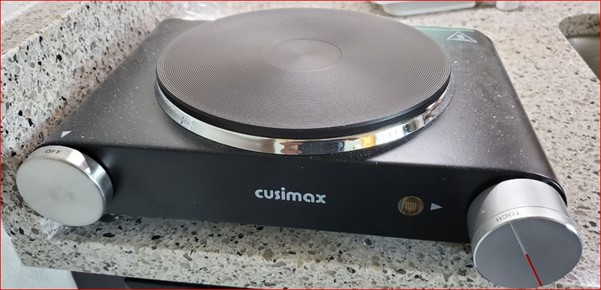
Caption: Stove with Reminder Knobs
See a detailed recipe (with kit lists) for implementing Frank’s Stove Minder solution (including different options for gas or electric stoves) here:
Editor’s Note: There are some other approaches to stove safety as well as this one. For example you can get burners that limit stove temperature (thus preventing fires), and automatic extinguishers. See the panel at the bottom of the page for some relevant stove safety products from our listings database.
4: Sink Minder
Who left that water running?
A touchless faucet in the kitchen is not only convenient, especially if your hands are dirty, but also includes an automatic shutoff for those who may be forgetful and leave the faucet running.
Since it was time to replace my old faucet, I thought it would be a great time to upgrade to a faucet with ease of use and handling the problem of forgetting to turn it off.
Frank has a DIY solution that involves several different options — including different types of auto shut off faucets, and several different options for sensors that detect water leaks.
See a detailed recipe (with kit lists) for implementing Frank’s solutions here:
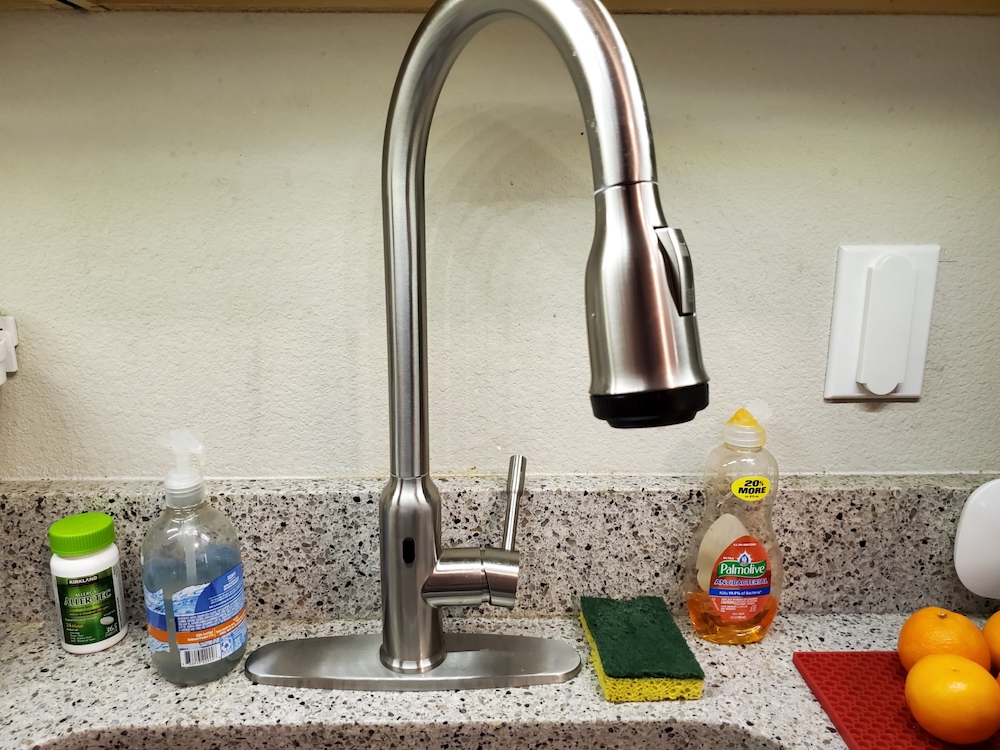
Caption: touchless faucet
5: Touchless Trash Can
If you have your hands full and want a clean easy way to open the trash can, look at this one that detects your presence and opens and closes.
- If you want to implement the touchless trash can features, see the Smart Kitchen Kit List for the product you will need.
DIY Tips & Implementation Suggestions
Some of my solutions are overly complex because smart home device makers have not yet fully integrated their IOT (Internet-of-Things) devices with other makers software. For example, there are door contact sensor manufacturers that can detect a fridge door being “left open”, but they can only report that event within their own infrastructure or to their app on YOUR smartphone.
My Use Case does NOT expect your loved one to be a smart phone user.
My workaround was to use several Alexa Routines and IFTTT applets to detect the “left open” state and provide repeated alerts.
Although the water leak sensor was only used under the kitchen sink in this “kitchen focused” article, I suggest you add water leak sensors under the fridge, dishwasher, washing machine, bathroom and near the water heater. I have family members who have experienced expensive floor repairs due to leaking appliances.
Learn More
- For the big picture about smart homes and older adults see Smart Home for Seniors: What, Why? and the Topic Hub: Smart Home, Artificial Intelligence, Robots.
- Feel free to add questions or comments below in the comments section.
- Want to join our community and engage more deeply? See below.
*Disclosure: The research and opinions in this article are those of the author, and may or may not reflect the official views of Tech-enhanced Life.
If you use the links on this website when you buy products we write about, we may earn commissions from qualifying purchases as an Amazon Associate or other affiliate program participant. This does not affect the price you pay. We use the (modest) income to help fund our research.
In some cases, when we evaluate products and services, we ask the vendor to loan us the products we review (so we don’t need to buy them). Beyond the above, Tech-enhanced Life has no financial interest in any products or services discussed here, and this article is not sponsored by the vendor or any third party. See How we Fund our Work.
